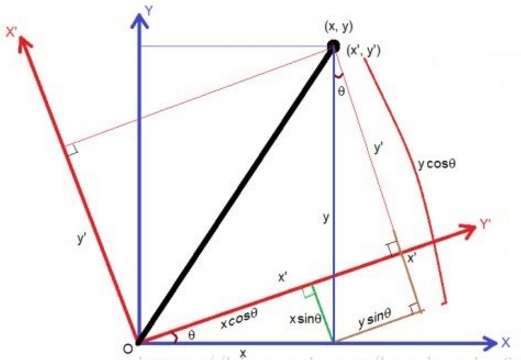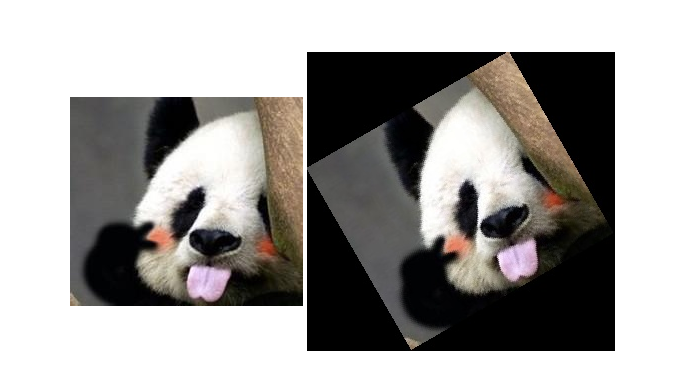|
|
OpenCV图像旋转
图像旋转是指图像按照某个位置转动一定角度的过程,旋转中图像仍保持这原始尺寸。图像旋转后图像的水平对称轴、垂直对称轴及中心坐标原点都可能会发生变换,因此需要对图像旋转中的坐标进行相应转换。 如下图:
OpenCV图像旋转

OpenCV图像旋转

同时我们要修正原点的位置,因为图像中的坐标原点在图像的左上角,经过旋转后图像的大小会有所变化,原点也需要修正。实现代码如下: - #include "opencv2/core/core.hpp"
- #include "opencv2/imgproc/imgproc.hpp"
- #include "opencv2/highgui/highgui.hpp"
- #include <iostream>
- #include <string>
- #include <cmath>
- using namespace cv;
- Mat imgRotate(Mat matSrc, float angle, bool direction)
- {
- float theta = angle * CV_PI / 180.0;
- int nRowsSrc = matSrc.rows;
- int nColsSrc = matSrc.cols;
- // 如果是顺时针旋转
- if (!direction)
- theta = 2 * CV_PI - theta;
- // 全部以逆时针旋转来计算
- // 逆时针旋转矩阵
- float matRotate[3][3]{
- {std::cos(theta), -std::sin(theta), 0},
- {std::sin(theta), std::cos(theta), 0 },
- {0, 0, 1}
- };
- float pt[3][2]{
- { 0, nRowsSrc },
- {nColsSrc, nRowsSrc},
- {nColsSrc, 0}
- };
- for (int i = 0; i < 3; i++)
- {
- float x = pt[i][0] * matRotate[0][0] + pt[i][1] * matRotate[1][0];
- float y = pt[i][0] * matRotate[0][1] + pt[i][1] * matRotate[1][1];
- pt[i][0] = x;
- pt[i][1] = y;
- }
- // 计算出旋转后图像的极值点和尺寸
- float fMin_x = min(min(min(pt[0][0], pt[1][0]), pt[2][0]), (float)0.0);
- float fMin_y = min(min(min(pt[0][1], pt[1][1]), pt[2][1]), (float)0.0);
- float fMax_x = max(max(max(pt[0][0], pt[1][0]), pt[2][0]), (float)0.0);
- float fMax_y = max(max(max(pt[0][1], pt[1][1]), pt[2][1]), (float)0.0);
- int nRows = cvRound(fMax_y - fMin_y + 0.5) + 1;
- int nCols = cvRound(fMax_x - fMin_x + 0.5) + 1;
- int nMin_x = cvRound(fMin_x + 0.5);
- int nMin_y = cvRound(fMin_y + 0.5);
- // 拷贝输出图像
- Mat matRet(nRows, nCols, matSrc.type(), Scalar(0));
- for (int j = 0; j < nRows; j++)
- {
- for (int i = 0; i < nCols; i++)
- {
- // 计算出输出图像在原图像中的对应点的坐标,然后复制该坐标的灰度值
- // 因为是逆时针转换,所以这里映射到原图像的时候可以看成是,输出图像
- // 到顺时针旋转到原图像的,而顺时针旋转矩阵刚好是逆时针旋转矩阵的转置
- // 同时还要考虑到要把旋转后的图像的左上角移动到坐标原点。
- int x = (i + nMin_x) * matRotate[0][0] + (j + nMin_y) * matRotate[0][1];
- int y = (i + nMin_x) * matRotate[1][0] + (j + nMin_y) * matRotate[1][1];
- if (x >= 0 && x < nColsSrc && y >= 0 && y < nRowsSrc)
- {
- matRet.at<Vec3b>(j, i) = matSrc.at<Vec3b>(y, x);
- }
- }
- }
- return matRet;
- }
- int main()
- {
- std::string strPath = "D:\\MyDocuments\\My Pictures\\OpenCV\";
- Mat matSrc = imread(strPath + "panda.jpg");
- if (matSrc.empty())
- return 1;
- float angle = 30;
- Mat matRet = imgRotate(matSrc, angle, true);
- imshow("src", matSrc);
- imshow("rotate", matRet);
- // 保存图像
- imwrite(strPath + "rotate_panda.jpg", matRet);
- waitKey();
- return 0;
- }
OpenCV图像旋转

|
|
 |免责声明|小黑屋|依星资源网
( 鲁ICP备2021043233号-3 )|网站地图
|免责声明|小黑屋|依星资源网
( 鲁ICP备2021043233号-3 )|网站地图